

Maria da Glória (detail)
Manuel Dias de Oliveira (1763/4, Cachoeiras de Macacu - 25 April 1837, Campos dos Goytacazes) was a Brazilian painter, decorator and art professor.


Manuel Dias de Oliveira (1763/4, Cachoeiras de Macacu - 25 April 1837, Campos dos Goytacazes) was a Brazilian painter, decorator and art professor.
When he was a young man, he moved to Rio de Janeiro, where he studied toreutics, which suggests that he may have worked as a goldsmith. [1] A Portuguese merchant provided funds for further studies in Porto, but the merchant died, leaving Dias stranded there. [2]
He made his way to Lisbon, where he found refuge at the Casa Pia; [2] an educational institution for young vagabonds, founded by Pina Manique in 1780. The residents were taught skills such as mathematics and drawing, while doing manual labor to pay their way. He proved to be an outstanding student and was sent to Rome to further improve his talents.
Thanks to Manique's personal support, he was able to enter the Accademia di San Luca, where he was one of Pompeo Batoni's last students. [1] He remained in Italy until 1800, when he returned to Portugal. Once there, he was immediately approached with a proposal to establish a new art school in Brazil. He accepted and the "Aula Régia de Desenho e Figura" was opened in Rio de Janeiro later that year. [1]
It was the first formal art school in the colony. He followed the European style of teaching, which included the use of nude models; a controversial innovation at that time. [2] His best known student is Francisco Pedro do Amaral a fellow Brazilian painter. He also worked as a decorator for special events; notably the visit of the Portuguese Royal Family in 1808. [1]
After the arrival of the French Artistic Mission in 1816, his prestige declined. In 1822, Emperor Pedro I withdrew his support, in favor of the new Academia Imperial de Belas Artes. [1] Dias was not offered a position there so, after almost a decade of being a free-lance artist, he moved to Campos de Goytacazes and operated a regular elementary school until his death. The majority of his works were of an ephemeral nature and have not survived.

Nilo Procópio Peçanha was a Brazilian politician who served as seventh president of Brazil. He was governor of Rio de Janeiro (1903–1906), then elected the fifth vice president of Brazil in 1906. He assumed the presidency in 1909 following the death of President Afonso Pena and served until 1910.

Campos dos Goytacazes is a municipality located in the northern region of Rio de Janeiro State, Brazil, with a population of 471,737 inhabitants.

Manuel Antônio de Almeida was a Brazilian satirical writer, medician and teacher. He is famous for the book Memoirs of a Police Sergeant, written under the pen name Um Brasileiro. He is the patron of the 28th chair of the Brazilian Academy of Letters.

Tobias Barreto de Meneses was a Brazilian poet, philosopher, jurist and literary critic. He is famous for creating the "Condorism" and revolutionizing Brazilian Romanticism and poetry. He is patron of the 38th chair of the Brazilian Academy of Letters.

Henrique Maximiano Coelho Neto was a Brazilian writer and politician. He founded and occupied the second chair of the Brazilian Academy of Letters, from 1897 until his death in 1934. He was also the president of the aforementioned Academy in 1926.

Manuel José de Araújo Porto-Alegre, Baron of Santo Ângelo, was a Brazilian Romantic writer, painter, architect, diplomat and professor, considered to be one of the first Brazilian editorial cartoonists ever. He is the patron of the 32nd chair of the Brazilian Academy of Letters.

Angenor de Oliveira, known as Cartola, was a Brazilian singer, composer and poet considered to be a major figure in the development of samba.

Pedro Américo de Figueiredo e Melo was a Brazilian novelist, poet, scientist, art theorist, essayist, philosopher, politician and professor, but is best remembered as one of the most important academic painters in Brazil, leaving works of national impact. From an early age he showed an inclination towards the arts, being considered a child prodigy. At a very young age, he participated as a draftsman on an expedition of naturalists through the Brazilian northeast, and received government support to study at the Imperial Academy of Fine Arts. He did his artistic improvement in Paris, studying with famous painters, but he also dedicated himself to science and philosophy. Soon after his return to Brazil, he began to teach at the Academy and began a successful career, gaining prominence with great paintings of a civic and heroic character, inserting himself in the civilizing and modernizing program of the country fostered by emperor Pedro II, of which the Imperial Academy was the regulatory and executive arm in the artistic sphere.
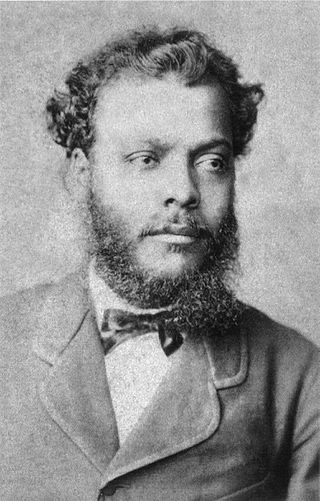
José Carlos do Patrocínio was a Brazilian writer, journalist, activist, orator and pharmacist. He was among the most well-known proponents of the abolition of slavery in Brazil, and known as "Tigre da Abolição". He founded and occupied the 21st chair of the Brazilian Academy of Letters from 1897 until his death in 1905.

Rodolfo Amoedo was a Brazilian painter, designer and decorator.

The Portuguese royal court transferred from Lisbon to the Portuguese colony of Brazil in a strategic retreat of queen Maria I of Portugal, prince regent John, the Braganza royal family, its court, and senior officials, totaling nearly 10,000 people, on 27 November 1807. The embarkment took place on the 27th, but due to weather conditions, the ships were only able to depart on 29 November. The Braganza royal family departed for Brazil just days before Napoleonic forces invaded Portugal on 1 December 1807. The Portuguese crown remained in Brazil from 1808 until the Liberal Revolution of 1820 led to the return of John VI of Portugal on 26 April 1821.

Events in the year 1889 in Brazil.
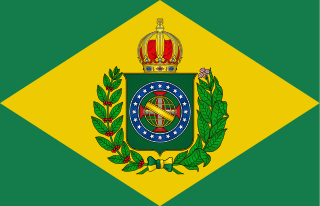
Events in the year 1883 in Brazil.
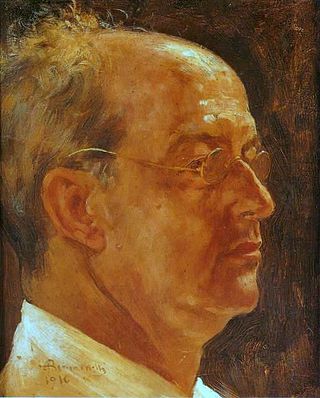
Henrique Bernardelli was a Brazilian painter.

Francisco Pedro do Amaral was a Brazilian painter, designer, scenographer and gilder.
João Alves Peixoto was a Brazilian politician.
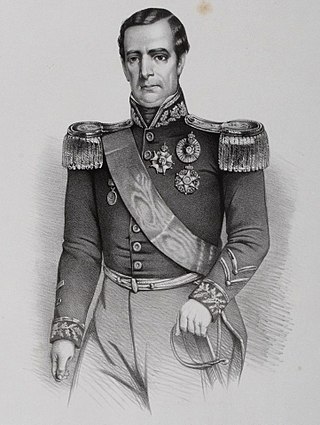
Francisco de Lima e Silva was a Brazilian military officer and politician who served twice as regent of the Empire of Brazil during the minority of emperor Pedro II.
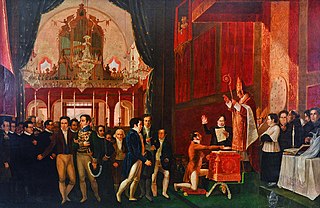
The regency period is how the decade from 1831 to 1840 became known in the history of the Empire of Brazil, between the abdication of Emperor Pedro I, on 7 April 1831, and the declaration of age of Pedro II, who was legally declared of age by the Senate at the age of 14 on 23 July 1840.

Manuel Jacinto Nogueira da Gama, Marquis of Baependi, was a Brazilian military officer, politician, translator and professor, who received a doctorate in Mathematics and Philosophy from the University of Coimbra.
Adelina Gomes was a Brazilian painter, sculptor, florist, and artisan. As a painter, she created 17,500 works until her death in 1984.
![]() Media related to Manuel Dias de Oliveira at Wikimedia Commons
Media related to Manuel Dias de Oliveira at Wikimedia Commons